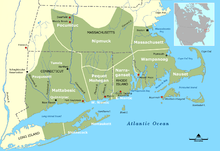Blackstone Park Conservation District
41°49′58″N 71°22′46″W / 41.832826°N 71.379334°W
| Blackstone Park Conservation District | |
|---|---|
 View of the Seekonk River, looking north from Blackstone Park. | |
 | |
| Type | Urban park |
| Location | Providence, Rhode Island |
| Area | 45 acres (18 ha) |
| Created | 2003 |
| Operated by | Blackstone Parks Conservancy |
The Blackstone Park Conservation District is a public, 45-acre
Ecology
Ecologically, the Blackstone Conservation District is a
The woods and shoreline are home to many species of
- Ecosystem threats
The conservation district aims to promote the survival of native species and to maintain an
History of the site

The park is situated in an area where people of the
In the 1700s, the site was a part of the 300-acre farm owned by a wealthy merchant and abolitionist
Beginning in the 1890s, the city began to expand and develop the park, purchasing eighteen acres from landowners in 1893 and additional land acquired over subsequent decades.
A boathouse for the Narragansett Boat Club sits on the riverbank at the intersection of Angel Street and River Road. The club was founded in 1838 and is the oldest continuous rowing club, perhaps the oldest continuous athletic club, in the United States.[14] The boathouse was designed in 1891 by architect George Frederic Hall, who was also a club member.[15]
In the 1930s, during the Great Depression, the federal government's Works Progress Administration built the park's waterfront.[16] The Federal Emergency Relief Administration also likely contributed to the park's development.[16] Workers added granite stairs, curbs, and made other improvements throughout the park.[13]
Management and funding
The Blackstone Parks Conservancy and the City of Providence Parks Department jointly manage both the Blackstone Park Conservation District and the nearby Blackstone Boulevard Park.[2] In addition to public funding and private donations, the Rhode Island Coastal Resources Management Council (CRMC) provided partial funding to the Conservancy in 2020 for coastal upland edge restoration, to mitigate trail erosion.[17][6] The CRMC also provided a 2017 grant to mitigate erosion, plant native species and add fencing to protect the new plants.[7]
Images of the conservation district
-
Walking trail in Blackstone Park Conservation District.
-
Blackstone Park entrance at Parkside Rd.
-
Blackstone Park entrance at Angell St. and Albin Moser Boathouse.
-
View from Blackstone Park toward the Henderson Bridge and Seekonk River.
-
Waterway in Blackstone Park.
See also
- Blackstone Boulevard Park
- Blackstone Park Historic District
- Blackstone Boulevard Realty Plat Historic District
- Urban green space
- Conservation Biology
- Biodiversity
References
- ^ a b "Neighborhood Parks". City of Providence Parks Department. Retrieved October 21, 2020.
- ^ a b c d e f g "Blackstone Parks Conservancy". Blackstone Parks Conservancy. Retrieved October 17, 2020.
- ^ a b "Northeastern coastal forest". World Wildlife Foundation. Retrieved October 21, 2020.
- ^ a b c "Plants". Blackstone Parks Conservancy. Blackstone Parks Conservancy. Retrieved January 10, 2024.
- ^ a b "Blackstone Park, Providence". p. eBird. Retrieved July 23, 2022.
- ^ a b c "CRMC funds seven habitat restoration projects". RI Coastal Resources Management Council. April 3, 2020. Retrieved January 10, 2024.
- ^ a b c "CRMC funds seven habitat restoration projects". RI Coastal Resources Management Council. March 22, 2017. Retrieved January 10, 2024.
- ^ a b "Historical Perspective of the Narragansett Indian Tribe". Narragansett Indian Tribe. Retrieved October 17, 2020.
- ^ ISBN 9780806135984.
- ^ a b Parsons, Usher (1861). "Indian Names of Places in Rhode Island - Usher Parsons, Rhode Island Historical Society - Google Books". Retrieved September 14, 2022.
- ^ a b Rhode Island Educational Circulars: Historical series, Volumes 1-6. Office of Commissioner of Education, State of Rhode Island. 1908. Retrieved October 17, 2020.
- ^ a b c "Blackstone Park Historic District - National Register of Historic Places Registration Form" (PDF). National Park Service, United States Department of the Interior. Retrieved October 18, 2020.
- ^ a b c d "History". Blackstone Parks Conservancy. Blackstone Parks Conservancy. Retrieved January 10, 2024.
- ^ a b Providence Directory. Providence, Rhode Island: Sampson, Murdock & Co. 1889.
- ^ Engineering Record 25 April 1891: 352.
- ^ a b c "Blackstone Park – Providence RI". Living New Deal. Retrieved January 10, 2024.
- ^ a b "CRMC Funds Seven R.I. Habitat Restoration Projects". ecoRI News. April 8, 2020. Retrieved October 18, 2020.
- ^ "Invasives". Blackstone Parks Conservancy. Blackstone Parks Conservancy. Retrieved January 10, 2024.





